QuickStart LPU-O
Overview
Seoul Robotics’ LPU-O is a GPU-enabled machine that can be used as a dedicated Lidar Processing Unit. The LPU-O has been designed to run SENSR on an Edge device with up to eight 32-channels LiDARs. This page describes how to use the LPU-O. The detailed LPU user manual can be downloaded here.

Hardware
Physical Characteristics
| GPU | NVIDIA Orin |
|---|---|
| RAM | 32GB |
| Network | 1x GbE RJ-45 1x 10G RJ-45 |
| Display output | 1x HDMI 2.0 (3840x2160 at 60Hz) |
| Temperature | Operating temperature -25°C~65°C (TBD) Storage temperature -40°C ~ 85°C Relative humidity 40 °C @ 95%, Non-Condensing |
| USB | 2x USB 2.0 Type-A 2x USB 3.2 Type-A |
| Storage | 1x micro-SD card slot |
| Input Power | DC Range 12~54V (7~1.95A) ATX 4-pin: 12~54V (10.8~2.4A) Power: 60W |
| Expansion Header | 40-pin (UART, SPI, CAN, I2C, I2S, GPIOs ) |
| Buttons | Power and Recovery |
| Cooling | Heatsink + Fan |
| Certifications | CE, FCC, KC |
Connections
The LPU has several ports for connecting different equipment.
- LiDARs should be connected to the SENSORS LAN port
- External networks such as Internet, external systems consuming SENSR data shall be connected to the OUTPUT LAN port
- The power adapter should be connected to the barrel jack connector
- A display device should be connected to the HDMI port for remote support. If you do not connect a display device, plug in the included dummy HDMI.
Refer to the User Manual for in-depth details.
Software
Operating System
The LPU-O runs on Ubuntu 20.04 and JetPack 5.1.1. It is recommended to use static IP settings for both the SENSOR and the OUTPUT network interface.
The link here details how to set static IP addresses in Ubuntu.
Natively, Ubuntu can encounter difficulties for reconnecting to the internet after a disconnection due to its DNS priority management. The script below can be run through a service to enable reconnection on the OUTPUT port when internet becomes available again
while true; do
if ! ping -c 1 8.8.8.8 &> /dev/null; then
echo "Internet connection lost, reconnecting eth0"
ifmetric eth0 10
ifmetric eth1 50
fi
sleep 10
done
Cluster Recommendations
If running the LPU-O in an environment with an unstable network connection, consider using 172.17.0.1 (Docker interface) to run the Cluster.
When the connection to external networks is stable, it is recommended using the IP address on the OUTPUT network interface. Please note that in case of network disruption, on the selected network interface, SENSR may need to be restarted.
More information on the Cluster page.
Performance
Processing Capacity
A single LPU-O unit can efficiently process data from 8 32 channels LiDARs and a single machine can cover a detection range of about 15,000 m².
Resource Management
Ensure a minimum of 80% CPU and memory availability in production environments.
To ensure the system is processing data with the right level of performance, ensure that the average performance of the system in Runtime > View > System Monitor remains below 100ms. This ensures that the data is processed by SENSR at least at the same frequency as the receiving frequency.
Integration
When co-locating SENSR with other applications in the same host, ensure the overall LPU performance remains within recommended values, minimize size.
If your application is running on Kubernetes, please contact support@seoulrobotics.org for integration support.